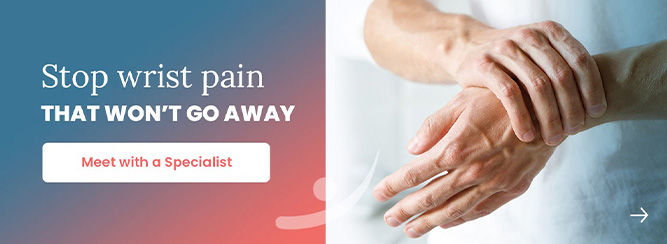De Quervain's Stenosing Tenosynovitis
Once called Washer Woman’s Sprain, this painful inflammation of the thumb side of the wrist now bears the name of the Swiss surgeon, Fritz de Quervain, who wrote about this condition in 1895.
What is De Quervain’s Stenosing Tenosynovitis?
Passing over the back of the wrist are the tendons for muscles that extend or straighten the fingers and thumb, and lift the hand at the wrist. These tendons run through six lubricated tunnels (compartments) under a thick fibrous layer called the extensor retinaculum.
The first dorsal compartment lies over the bony bump at the base of the thumb. Through it pass the tendons for the abductor pollicis longus (APL) and the extensor pollicis brevis (EPB) muscles. Both of these muscles help spread and extend the thumb away from the rest of the hand.
De Quervain’s Stenosing Tenosynovitis is a painful inflammation of the tendons in the first dorsal compartment of the wrist. The lubricating synovial sheath lining this compartment thickens and swells, giving the enclosed tendons less room to move, and produces extra synovial fluid. A painful cyst may also form in this area because of the increased tissue in the compartment.
Read our “What Is De Quervain’s Stenosing Tenosynovitis?” Patient Handout
What Are the Causes of De Quervain’s Stenosing Tenosynovitis?
This inflammation may be caused by any condition that changes the shape of the compartment or causes swelling or thickening.
Who gets De Quervain’s Stenosing Tenosynovitis?
De Quervain’s Stenosing Tenosynovitis occurs most often in individuals between the ages of 30 and 50. Women are afflicted with this condition 8 to 10 times more often than men. People who engage in activities requiring sideways motion of the wrist while gripping the thumb, as in hammering, skiing, some assembly line jobs, may be predisposed to developing this disorder.
What are the Signs and Symptoms of De Quervain’s Stenosing Tenosynovitis?
Pain over the thumb side of the wrist is the primary symptom. This condition may occur “overnight” or very gradually, and it may radiate pain into the thumb and up the forearm. It becomes worse with the use of the hand and thumb, especially with any forceful grasping, pinching, or twisting. Swelling over the thumb side of the wrist may be present, as well as some “snapping” when the thumb is moved. Because of the pain and swelling, there may be some decreased thumb motion.
Besides pain and swelling over the first dorsal compartment, having a positive Finkelstein’s Test is a good indication the patient has this problem. In this test, the patient makes a fist with his or her thumb placed under the fingers. Then the patient bends the wrist away from the thumb and towards the little finger side of the hand. This test is mildly painful to many of us, but to someone with de Quervain’s Stenosing Tenosynovitis, it is very painful.

Conservative Management
Your doctor may first try to reverse the course of the disease with a 3 to 6 week trial of anti-inflammatory medication, while the wrist and thumb are rested by wearing a wrist and thumb spica splint. Your physician may also inject the area with a small amount of steroid to help decrease the inflammation.
If Surgery is Necessary
If the symptoms of de Quervain’s Stenosing Tenosynovitis disease are long-standing or are unresponsive to conservative management, surgery is indicated. This type of surgery is usually performed on an outpatient basis.
During surgery, an incision is made over the first dorsal compartment. The ligament that makes up the roof of the tunnel is cut to release the APL and EPB tendons. The wound is then closed, and a compressive dressing is applied.
What to Expect Following Surgery
A prescription for pain medication will be provided. The bulky dressing is removed within 5 – 14 days after surgery, and an exercise program for the thumb and wrist is started. It usually takes several weeks for a full recovery. De Quervain’s Stenosing Tenosynovitis rarely recurs after proper surgical intervention.
Disclaimer: The materials on this website have been prepared for informational purposes only and do not constitute advice. You should not act or rely upon any medical information on this website without a physician’s advice. The information contained within this website is not intended to serve as a substitution for a thorough examination from a qualified healthcare provider. The display of this information is not intended to create a health care provider-patient relationship between the Indiana Hand to Shoulder Center and you.
